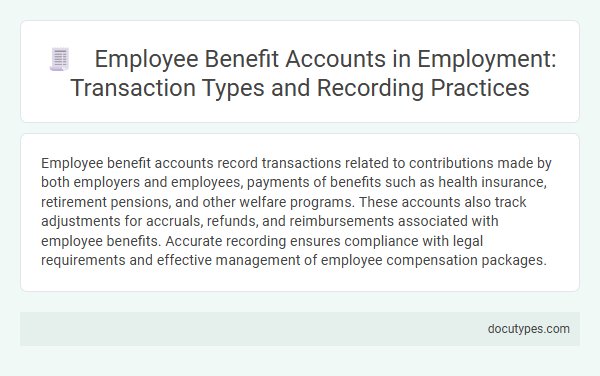Employee benefit accounts record transactions related to contributions made by both employers and employees, payments of benefits such as health insurance, retirement pensions, and other welfare programs. These accounts also track adjustments for accruals, refunds, and reimbursements associated with employee benefits. Accurate recording ensures compliance with legal requirements and effective management of employee compensation packages.
Overview of Employee Benefit Accounts
| Transaction Type | Description | Examples |
|---|---|---|
| Contributions | Funds deposited into employee benefit accounts by employers or employees to finance benefits. | Employer pension contributions, employee 401(k) deferrals, health savings account deposits |
| Investment Earnings | Interest, dividends, and capital gains earned on the invested funds within the account. | Dividends from mutual funds, interest from bonds, gains from stock appreciation |
| Benefit Distributions | Payments made to employees or beneficiaries when benefits are accessed or paid out. | Pension payments, health insurance claim reimbursements, retirement account withdrawals |
| Administrative Fees | Charges deducted from the account to cover management or maintenance expenses. | Plan management fees, recordkeeping charges, trustee fees |
| Adjustments | Corrections or changes reflecting amendments, errors, or regulatory compliance updates. | Account reclassifications, retroactive contribution corrections, legal settlements |
Types of Employee Benefits in Employment
What types of transactions are recorded in employee benefit accounts? Employee benefit accounts track contributions, allocations, and distributions related to various employee benefits. These transactions include employer and employee contributions, investment earnings, and benefit payments.
Which types of employee benefits are commonly recorded in these accounts? Key benefits include retirement plans like 401(k)s, health savings accounts (HSAs), flexible spending accounts (FSAs), and life insurance. Your employee benefit account provides a comprehensive record of all these transactions to ensure accurate tracking.
Common Transaction Types in Benefit Accounts
Employee benefit accounts track various transactions critical to managing employee compensation and perks. These accounts help ensure accurate record-keeping for both employees and employers regarding benefits.
- Contributions - Employer and employee payments made into benefit plans such as retirement or health insurance accounts.
- Distributions - Withdrawals or payments from benefit accounts, including pension payouts or health reimbursements.
- Adjustments - Corrections or updates to account balances due to errors, policy changes, or employee status updates.
Accurate recording of these transactions supports compliance and transparency in employee benefits management.
Recording Contributions to Benefit Accounts
Employee benefit accounts primarily record transactions related to contributions, distributions, and adjustments. Recording contributions involves documenting the amounts you or your employer deposit into retirement plans, health savings accounts, or other benefit programs. Accurate recording ensures proper tracking of funds and compliance with regulatory requirements.
Accounting for Employer-Paid Benefits
Employee benefit accounts record transactions related to employer-paid benefits such as health insurance, retirement plan contributions, and paid leave. These accounts track both the cost incurred by the employer and the liabilities associated with these benefits.
Accounting for employer-paid benefits involves recognizing expenses when the benefits are earned by employees, not when payments are made. This ensures accurate matching of costs with the periods in which employees provide services.
Handling Employee Benefit Deductions
Employee benefit accounts record transactions related to contributions made by both employers and employees toward benefits such as health insurance, retirement plans, and stock options. Handling employee benefit deductions involves accurately withholding amounts from employee wages for premiums, retirement fund contributions, and other benefit-related payments. These deductions are recorded to ensure proper allocation, compliance with regulations, and transparent tracking of benefit liabilities and expenses.
Tax Implications of Employee Benefit Transactions
Employee benefit accounts record various transactions including contributions, withdrawals, and employer matching deposits. These entries track the flow of funds related to retirement plans, health savings accounts, and other employee benefits.
Tax implications play a crucial role in these transactions, influencing your taxable income and potential deductions. Contributions may be pre-tax or after-tax, affecting how and when taxes are applied to the funds in your benefit accounts.
Best Practices for Benefit Account Reconciliation
Employee benefit accounts record various transactions that track contributions, distributions, and adjustments related to employee benefits. Accurate reconciliation of these accounts ensures financial integrity and compliance with regulatory standards.
- Contributions - Records of employer and employee payments into benefit plans, including retirement, health, and welfare benefits.
- Distributions - Documentation of payments or reimbursements made to employees as part of the benefits, such as pension payouts or health claims.
- Adjustments - Updates to correct errors, account for plan amendments, or reflect changes in employee eligibility or status.
Compliance and Regulatory Requirements
Employee benefit accounts record transactions related to contributions, distributions, and investment earnings. Compliance with regulatory requirements ensures accurate tracking of these transactions to maintain plan integrity.
Transactions include employer and employee contributions, benefit payments, loan repayments, and forfeitures. Accurate record-keeping complies with IRS and Department of Labor regulations, preventing penalties. Detailed tracking supports audits and ensures transparency in plan administration.
What Types of Transactions are Recorded in Employee Benefit Accounts? Infographic

